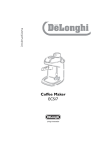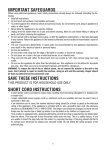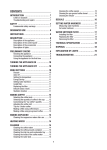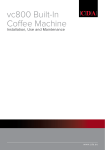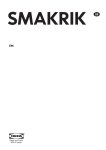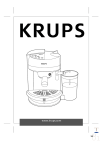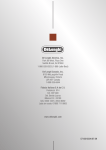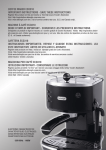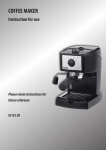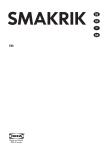Download DeLonghi Icona Vintage ECOV310.GR
Transcript
Introduction Attention: The appliance is not intended for use by persons (including children) with reduced physical, sensory or mental capabilities, or lack of experience and knowledge, unless they have been given supervision or instruction concerning use of the appliance by a person responsible for their safety. Children should be supervised to ensure that they do not play with the appliance. Thank you for having chosen our coffee machine. We hope you have fun with your new appliance. Take a few minutes to read these instructions. This is the only way to avoid danger and damage to the machine. Symbols used in these instructions The important recommendations have these symbols. These recommendations must be followed. Scalding hazard! This appliance produces hot water and steam may form when it is operating. Pay attention not to come into contact with hot water sprays or steam. Do not touch the cup warmer plate when the appliance is on; it is hot. Danger! Failure to comply can be or is the cause of injury due to life-threatening electric shocks. Attention! Failure to comply can be or is cause of injury or damage to the appliance. Use in compliance with destination. This appliance is manufactured for the preparation of coffee and to heat beverages. The appliance is designed and produced for domestic use only. It is not suitable for use in: - staff kitchens in shops, offices and other workplaces. - farm houses - hotels, motels or other holiday accommodation - guest houses Any other use must be considered improper and therefore dangerous. The manufacturer is not liable for damage deriving from the improper use of the appliance. Instructions for use Read these instructions carefully before using the appliances. - Failure to comply with these instructions can lead to injury and damage to the machine. The manufacturer is not liable for damage deriving from the failure to comply with the user instructions. Scalding hazard! Failure to comply can be or is the cause of scalding or burns. Nota Bene: This symbol highlights recommendations and important information for the user. Safety Fundamental recommendations regarding safety Danger! As the appliance operates using electric current, electric shocks can not be excluded. Therefore, follow the safety recommendations given: • Do not touch the appliance when you have wet hands or feet. • Do not touch the plug with wet hands. • Make sure that the socket used can always be easily reached, so that the plug can be removed when required. • Remove the plug from the socket by acting directly on the plug itself. Do not pull the cable as damage could be caused. • Remove the plug from the socket to disconnect the appliance completely. • Do not attempt to repair the appliance if it should breakdown. Switch the appliance off, remove the plug from the socket and contact the After-Sales Service. • If the plug or power supply cable are damaged, have them replaced exclusively by the De’Longhi After-Sales Service, in order to prevent risks. Nota Bene: Keep these instructions carefully. If the appliance should be transferred to other persons, these instructions must accompany it. description 1. Control panel 2. Steam knob 3. Water tank 4. Water tank lid 5. Power supply cable 6. Steam or hot water tube 7. Cup tray 8. Drip tray 9. Cappuccino maker 10.Nozzle 11.Boiler outlet 12.Coffee tamper 13.Measure for ground coffee Attention: Keep the packaging material (plastic bags, expanded polystyrene) out of the reach of children. 12 14.Filter-holder 15.Large filter 2 doses 7 16.Small 1 dose filter or for pods 17.Steam function selection button 18.Coffee or hot water tube 19.On/off button 20.On indicator light 21.OK indicator light 22.Steam function selected indicator light 23.Cup warmer plate tank itself. 3. Even easier, do not remove the tank, just fill it by pouring in water from a jug. Attention: do not operate the appliance without water in the tank and always fill it when the water is a few centimetres from the bottom. Nota Bene: it is normal to find water in the compartment under the tank; dry using a clean sponge. Preliminary operations HOW TO PREPARE ESPRESSO COFFEE Check after transport After the packaging has been removed, check the integrity of the appliance and the presence of all accessories. Do not use the appliance in the presence of obvious damage. Contact the De’Longhi After-Sales Service. Installing the appliance The following safety measures must be complied with when installing the appliance: • The appliance could be damaged by the penetration of water. Do not position the appliance near to water taps or sinks. • The appliance could be damaged if the water it contains freezes. Do not install the appliance in a room where the temperature can fall below freezing point. • Position the power supply cable in a way that it cannot be damaged by sharp edges or by contact with hot surfaces (e.g. electric plates). Pre-heating the coffee machine It is advised to pre-heat the coffee machine as follows in order to obtain an espresso coffee at the right temperature: 1. Press the ON/OFF button (the relative indicator light switches on) (fig. 4) and attach the empty filterholder to the machine (fig. 5). 2. Place a cup under the filter-holder. Use the same cup in which the coffee is to be served so that it can be pre-heated. 3. Wait until the OK light comes on (fig. 6) and then press the coffee button straight away (fig. 7). Allow the water to run until the OK light switches off and then stop the water by pressing the coffee button again (fig. 7). 4. Empty the cup, wait for the “OK” light to switch on again and repeat the same operation again. (It is normal for a small, harmless puff of steam to be released when the filter-holder is removed). Connecting the appliance HOW TO PREPARE THE ESPRESSO USING GROUND COFFEE Attention! Make sure that the electric mains voltage corresponds with that indicated on the data plate on the base of the appliance. 1. After having pre-heated the machine as described in the previous paragraph, insert the ground coffee filter into the filter-holder, making sure that the projection is correctly inserted into the relative seat as indicated in fig. 8. Use the smallest filter for one coffee or the larger one to make two cups of coffee. 2. To prepare one coffee, fill the filter with a level measuring spoon of ground coffee, about 7gr. (fig. 9). If you wish to prepare two cups of coffee, fill the filter with two less-than-level measuring spoons of ground coffee (about 6+6 gr). Fill the filter with small amounts at a time to prevent the coffee spilling out. • Only connect the appliance to correctly installed socket with minimum rating of 10A and efficient earthing. • In the case of incompatibility between the socket and the plug on the appliance, have the plug replaced by a qualified technician. • The power supply cable on this appliance must never be replaced by the user as special tools are needed for this operation. Contact an After-Sales Centre authorised by the manufacture if the cable is damaged or must be replaced, in order to avoid all risks. Filling the water tank 1. Open the water tank lid (fig. 1) and then lift the tank to remove it (fig. 2). 2. Fill the tank with fresh water but do not pass MAX. (fig. 3). Re-position the tank by pressing it lightly in a way to open the valve situated on the base of the Attention: for correct use, before filling the filter with ground coffee always make sure there is no residual coffee in the filter from the previous infusion. 3. Distribute the ground coffee evenly and press it lightly using the coffee tamper (fig. 10). 13 4. 5. 6. 7. Pressing the ground coffee is very important to obtain a good espresso. If you press too hard, the coffee will run out slowly and the cream will be dark. If you press too lightly, the coffee will run out too fast and the cream will be very light. Remove any excess coffee from the rim of the filterholder and attach it to the machine: turn the grip to the right (fig. 5) to prevent water from escaping. Position the cup or cups under the filter-holder spouts (fig. 11). It is recommended to warm the cups before making the coffee by running them under hot water or leaving them to pre-heat on the cup warmer for at least 15-20 minutes (fig. 12). Make sure that the OK light (fig. 6) is on (if it is off, wait for it to switch on) and press the coffee button (fig. 7). Once the desired amount of coffee has been obtained, press the same button again (fig. 7). (It is recommended not to run the coffee for more than 45 seconds). Turn the grip from right to left to release the filterholder. filter (fig. 14). Always follow the instructions of the pod pack for correct positioning of the pod on the filter. 4. Attach the filter-holder to the machine, turning it fully home (fig. 5). 5. Proceed as in points 5, 6 and 7 in the previous paragraph. HOW TO MAKE CAPPUCCINO 1. Prepare the espresso coffee as described in the previous paragraphs, using cups that are large enough. 2. Press the steam button (fig. 15). 3. In the meantime, fill a container with about 100 grams of milk for every cappuccino to be prepared. The milk must be at refrigerator temperature (not hot!). When choosing the container considers that the volume of the milk will increase by 2 or 3 times. Nota Bene: it is recommended to use semiskimmed milk at refrigerator temperature (+/5°C). Scalding hazard! To prevent sprays, do not release the filter-holder while the machine is dispensing coffee. 4. Position the container with the milk under the cappuccino maker. 5. Wait for the indicator light relative to the steam button to switch on (fig. 16). This indicates that the boiler has reached the ideal temperature for the production of steam 6. Open the steam tap for a few seconds to remove any water present in the circuit. Close the tap. 7. Dip the cappuccino maker into the milk for few millimeters (fig. 17) making sure not to immerse the raised line on the cappuccino maker (indicated by the arrow in fig. 17). Turn the knob anti-clockwise, fig. 18 for at least half a turn. Steam escapes from the cappuccino maker, giving the milk a creamy appearance and increasing its volume. To obtain a creamier froth, dip the cappuccino maker into the milk and turn the container with slow movements from the bottom upwards. 8. When the volume of the milk has doubled, dip the cappuccino maker deep down and continue to heat the milk. When the desired temperature (ideal value is 60°C) and the desired milk froth have been reached, interrupt the steam by turning the steam knob clockwise and release the steam button. Use the on/off button to switch the machine off (fig. 4) (The relative on light switches off). 9. Pour the frothed milk into the cups containing the previously-prepared espresso coffee. The cappuccino is ready: add sugar at will and if desired, sprinkle a little powdered chocolate on top of the froth. 8. To remove the used coffee, lock the filter using the lever in the grip and let the coffee fall out by knocking the over-turned filter-holder (fig. 13). 9. Turn the machine off by pressing the on/off button (fig. 4). Before using the machine for the first time all accessories and internal circuits must be washed by making at least five cups of coffee without using ground coffee. HOW TO PREPARE THE ESPRESSO USING PODS 1. Pre-heat the machine as described in the “PREHEATING THE COFFEE MACHINE” chapter, making sure that the filter-holder is attached to the machine. Hotter coffee is obtained in this way. Nota Bene: use pods that comply with the ESE Standard: this will be indicated on the packaging by the following mark. The ESE Standard is a system accepted by the leading coffee pod manufacturers and allows espresso coffee to be made simply and without making a mess. 2. Place the small filter in the filter-holder, making sure that the projection is correctly inserted into the relative seat as indicated in fig. 8. 3. Insert the pod, centring it as far as possible on the 14 CLEANING Nota Bene: • if more than one cappuccino is to be prepared, first make all of the coffees and then prepare the milk for all of the cappuccinos; • if more coffee must be prepared after the milk has been frothed, allow the boiler to cool first otherwise the coffee will be burned. To cool it, position a container under the filterholder spouts (fig. 11), press the steam button and allow water to run out until the steam function light switches off: then prepare the coffee. Maximum steam delivery of 60 seconds is recommended and the milk must not be frothed more than 3 times consecutively. Danger! Before performing any cleaning operations of the external parts of the appliance, switch the machine off, remove the plug from the socket and let the machine cool down. Cleaning and maintenance of the filter Clean the filter-holder and ground coffee filters about every 300 coffees and, however, when the coffee drips through the filter-holder and does not flow completely: • Remove the filter from the filter-holder. • Unscrew the filter cap (fig. 22) in the direction indicated by the arrow on the cap itself. • Slide the cream enhancer device from the container by pushing it from the cap end. • Remove the gasket. • Rinse all components and clean the metal filter thoroughly using hot water and a brush (fig. 23). Check that the holes in the metal filter are not blocked. If this is not the case, clean them using a pin (see fig. 24). • Re-mount the filter and the gasket on the plastic disc as indicated in figure 25. Make sure that the plastic disc pin is inserted inside the hole in the gasket as indicated by the arrow in fig. 25. • Re-insert the unit obtained into the steel container for the filter (fig. 26), making sure that the pin is inserted into the hole of the support itself (see arrow fig. 26). • Finally, tighten the tap. The warranty is not valid if the cleaning operations described above are not performed on a regular basis. Attention: the cappuccino maker must always be washed after use to ensure hygiene. Proceed as follows: 1. Discharge a small amount of steam for a few seconds (see points 2,5 and 6 of the previous paragraph) by turning the steam knob (fig. 18). By doing this, the cappuccino maker empties any milk left inside. Switch the machine off by pressing the ON/OFF button. 2. Use one hand to hold the cappuccino tube and the other to release the cappuccino maker by turning it clockwise and pulling it downwards (fig. 19). 3. Remove the steam nozzle from the tube by pulling it downwards (fig. 20). 4. Wash the cappuccino maker and steam nozzle thoroughly in warm water. 5. Make sure that the two holes indicated by the arrows in fig. 21 are not blocked. Clean using a pin if necessary. 6. Re-mount the steam nozzle by inserting it firmly upwards into the steam tube. 7. Re-mount the cappuccino maker by inserting it upwards and turning it anti-clockwise. Cleaning the boiler outlet About every 300 coffees the espresso boiler outlet must be cleaned as follows: • Make sure that the coffee machine is not hot and the plug is disconnected from the socket; • Use a screwdriver to remove the screw that fixes the espresso boiler outlet (fig. 27); • Remove the boiler outlet; • Clean the boiler using a damp cloth (fig. 27);10 • Clean the outlet thoroughly using hot water and a brush. Check that the holes are not blocked. If this is not the case, clean them using a pin (fig. 24). • Rinse the outlet under the tap, rubbing continuously. • Re-mount the boiler outlet, paying attention to position it correctly on the gasket. The warranty is not valid if the cleaning operations described above are not performed on a regular basis. PRODUCTION OF HOT WATER 1. Switch the machine on by pressing the on/off button (fig. 4). Wait for the OK light to switch on (fig. 6). 2. Position a container under the cappuccino maker. 3. Press the coffee button (fig. 7) and turn the steam knob anti-clockwise at the same time (fig. 18): the hot water will escape from the cappuccino maker. 4. To interrupt the hot water, turn the steam knob clockwise and press the coffee button again (fig. 7). Maximum delivery of 60 seconds is recommended. Other cleaning operations 1. Do not use solvents or abrasive detergents to clean the machine. Use a soft, damp cloth. 2. Clean the filter-holder cup, the filters, drip tray and water tank regularly. 15 technical data To empty the drip tray, remove the cup warmer grid, remove the water and clean the tray using a cloth: then re-assemble the drip tray. Clean the water tank using a soft bottle-brush in order to reach the bottom. Mains voltage: Absorbed power: Pressure: Water tank capacity: Dimensions LxHxD Weight Danger! During cleaning, never immerse the machine in water: it is an electric appliance. 220-240V~50/60Hz 1100W 15 bar 1,4 litres 255x315x280 (395) mm 3,9 kg The appliance is in compliance with the following CE Directives: • “Low voltage Directive” 2006/95/CE and successive amendments. • “EMC Directive” EMC 2004/108/CE and successive amendments. • The materials and objects destined to come into contact with food stuffs are in compliance with the provisions of the 1935/2004 European Standard. descaling It is recommended to descale the machine about every 200 coffees. It is recommended to use De’Longhi descaler that can be found on the market. Follow this procedure: 1. Fill the tank with the descaling solution obtained by diluting the descaler with water on the basis of the indications given on the pack. 2. Press the on/off button and wait for the OK light to switch on. 3. Make sure that the filter holder is not attached and position a container under the machine outlet. 4. Press the coffee button and allow about 1/4 of the solution contained in the tank flow out: every now and again turn the steam knob and allow a small amount of solution to escape; then interrupt by pressing the button again and leave the solution to act for about 5 minutes. 5. Repeat point 4 another 3 times, until the tank is completely empty. 6. To eliminate residues of the solution and lime scale, rinse the tank well and fill it with clean water (without descaler). 7. Press the coffee button (fig. 6) and operate the appliance until the tank is completely empty; 8. Repeat operations 6 and 7 again. Disposal Recommendations for the correct disposal of the product in compliance with the 2002/96/CE European Directive. The product must not be disposed of as urban waste at the end of its working life. It must be taken to appropriate local authority separate waste collection centres or to dealers providing this service. Disposing of a household appliance separately avoids possible negative consequences for the environment and health deriving from unsuitable disposal and allows to recover the materials of which it is made in order to make significant savings in energy and resources. The product has the crossed-out wheeled bin mark as a reminder of the obligation to dispose of household appliances separately. 16 Problem POSSIBLE CAUSES SOLUTION Espresso coffee does not flow out • No water in the tank • Fill the water tank • The holes in the filter-holder are blocked • Clean the holes in the filter-holder spouts • The espresso boiler outlet is blocked • Clean as indicated in the “Cleaning the boiler outlet” paragraph • The filter-holder is inserted incorrectly • Attach the filter-holder correctly and turn it fully home firmly • The espresso boiler gasket has lost elasticity • Replace the espresso boiler gasket at an After-Sales Centre • The holes in the filter-holder spout are blocked • Clean the holes in the spouts. • The espresso OK light is not on when the coffee button is pressed • Wait for the OK light to switch on • Pre-heating has not been carried out • Pre-heat as indicated in the paragraph • The cups have not been pre-heated • Pre-heat the cups using hot water or leaving them for at least 20 minutes on the cup warmer plate on the lid • The water tank is empty • Fill the water tank • The tank is inserted incorrectly and the valve on the bottom is not open • Press the tank lightly to open the valve on the bottom • The ground coffee has not been sufficiently pressed • Tamper the ground coffee more (fig. 10)) • Not enough ground coffee • Increase the amount of ground coffee • The coffee is not ground finely enough • Only use coffee ground specifically for espresso coffee machines • Incorrect type of ground coffee • Change the quality of the ground coffee • The ground coffee is too tightly pressed • Tamper the coffee less (fig. 6) • Too much ground coffee • Decrease the amount of ground coffee • The espresso boiler outlet is blocked • Clean as indicated in the “Cleaning the espresso boiler outlet” chapter. • The filter is blocked • Clean as indicated in the “cleaning the filter” par. • The coffee is too finely ground • Only use coffee ground specifically for espresso coffee machines • The ground coffee is too fine or is damp • Only use coffee ground specifically for espresso coffee machines and it must not be too damp • Incorrect type of ground coffee • Change the quality of the ground coffee powder • The milk is not cold enough • Always use milk at refrigerator temperature • The cappuccino maker is dirty • Carefully clean the holes in the cappuccino maker, in particular, those indicated in figure 21 Espresso coffee drips from the edges of the filter-holder instead of through the holes The espresso coffee is cold Loud pump noise The coffee cream is clear (it flows quickly from the spout) The coffee cream is dark (it flows slowly from the spout) The milk does not froth when making a cappuccino 17







